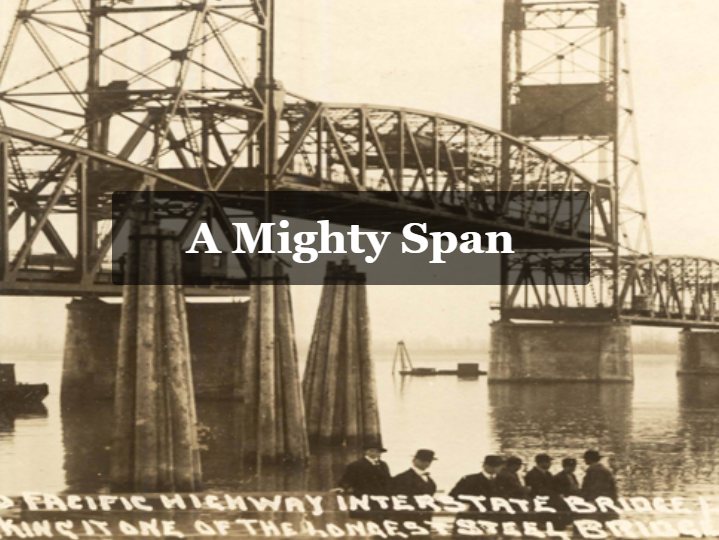A Mighty Span:
Exploring Radio Narratives As Electronic Literature
John Barber
The call for this exhibition suggests that works of electronic literature may be re/presented in other forms and/or media. Might this also work in reverse: re/presenting works in other forms and/or media as electronic literature?
"A Mighty Span" imagines a live radio broadcast of the celebrations surrounding the 1917 opening of Interstate Bridge spanning the Columbia River between Oregon and Washington. This work is proposed for exhibition as part of the ELO Conference + Media Arts Festival. The call for this exhibition suggests that works of electronic literature may be re/presented in other forms and/or media. Might this also work in reverse: re/presenting works in other forms and/or media as electronic literature? "A Mighty Span" suggests an affirmative answer. If electronic literature argues that its different affordances and agencies provide readers opportunities to re/present, re/experience literary events in ways more compelling than through text alone, "A Mighty Span" extends and re/presents this prompt to include sound-based radio narratives as offering immersive literary opportunities.
Specifically, "A Mighty Span" responds to the conference theme of "(un)continuity," the invitation to explore fluidity, re/presentation, and sound. The work draws inspiration from early radio news reporting and documentary and oral history to re/present sound-based narrative as a non-binary literary event. By bringing sound(s) to the forefront, "A Mighty Span," argues sound central to the literary experience. Sound puts one in the environment, the world, being depicted, helps one to navigate that space, and promotes believable experience of action and agency there. This is facilitated by hearing and listening, both participatory practices, wherein sound seizes / stimulates the imagination, promotes reflective inquiry, and prompts conceptual changes. By providing a portal into orality, engaging audiences in listening, and exploring sound as a fundamental component of narrative and literary experience, "A Mighty Span" explores a mode of communications reliant on storytelling, listening, and collaboration. We hear voices on the radio as the people speaking, as the persons they are, rather than personas depicted on a screen. Radio allows us to re/position ourselves, to be present, to re/present being interpersonal.
In these ways, "A Mighty Span" explores new forms and new media for electronic literature.
About the Artist
John F. Barber convenes with The Creative Media & Digital Culture program at Washington State University Vancouver. His scholarship, teaching, and creative endeavors arise from the intersection (collision, collusion?) of art, humanities, and technology where he feels that making is knowledge creation and art is knowledge in action. His creative practices with radio and sound art have been broadcast and exhibited internationally. His work with digital humanities is showcased by American Dust (www.brautigan.net), an online resource he developed and curates, known as the preeminent resource for the life and writing of American author Richard Brautigan. As a featured guest on This American Life, Barber talked about his The Brautigan Library project which archives and curates unpublished manuscripts by everyday authors. Barber's work has appeared in Digital Humanities Quarterly, Digital Studies, ebr, Hyperrhiz: New Media Cultures, Leonardo, MATLIT (Materialities of Literature), Scholarly Research and Communication, and other journals. Barber's website, www.nouspace.net/john, provides more details and examples of his endeavors.
